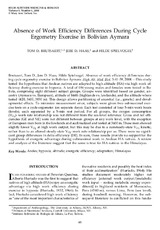Absence of work efficiency differences during cycle ergometry exercise in Bolivian Aymara

View/
Date
2004Author
Brutsaert, Tom D
Haas, Jere D
Spielvogel, Hilde
Metadata
Show full item recordAbstract
ABSTRACT.
This study tested the hypothesis that Andean natives are adapted to high altitude (HA) via high work ef
ficiency during exercise in hypoxia. A total of 186 young males and females were tested in Bo
livia, comprising eight different subject groups. Groups were identified based on gender, an
cestry (Aymara vs. European), altitude of birth (highlands vs. lowlands), and the altitude where
tested (420, 3600, 3850 m). This design allows partitioning of ancestral (i.e., genetic) and devel
opmental effects. To minimize measurement error, subjects were given two submaximal exer
cise tests on a cycle ergometer (on separate days). Each test consisted of four 5-min work bouts
(levels), each separated by a 5-min rest period. For all groups, the oxygen consumption
(VO2)–work rate relationship was not different from the sea-level reference. Gross and net effi
ciencies (GE and NE) were not different between groups at any work level, with the exception
of European men born in the lowlands and acclimatized and tested at 3600 m. These men showed
slightly lower VO2 at high work output, but this may be due to a nonsteady-state VO2 kinetic,
rather than to an altered steady-state VO2–work rate relationship per se. There were no signifi
cant group differences in delta efficiency (DE). In sum, these results provide no support for the
hypothesis of energetic advantage during submaximal work in Andean HA natives. A review
and analysis of the literature suggest that the same is true for HA natives in the Himalayas.
